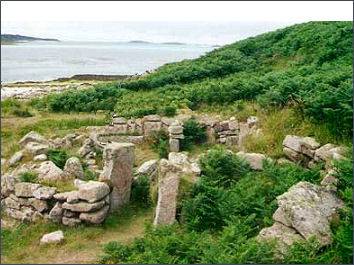Nornour
OS grid reference :- SV 944 148
 The tiny uninhabited island of Nornour lies in the Eastern Islands of the Isles of Scilly. Covering 4 acres, the island consists of a bracken covered hill and is joined at low tide to the neighboring island of Great Ganilly by a boulder causeway.
The tiny uninhabited island of Nornour lies in the Eastern Islands of the Isles of Scilly. Covering 4 acres, the island consists of a bracken covered hill and is joined at low tide to the neighboring island of Great Ganilly by a boulder causeway.
Known in Cornish as Ar Nor, which means facing the mainland, the island was inhabited for a long period during the Bronze and Iron Ages through to the early Romano-British period when it would have have formed part of the much larger single island of Scilly. Due to rising sea levels the island became an archipelago. Nornour appears to have formerly been a hillock overlooking the main Roman port on the single main island of Insula Sillina.
A violent storm which occured in 1962 eroded the sand dunes at Nornour, uncovering an extensive settlement of ancient hut circles and a shrine to the goddess Sillina who is linked to Sulis of Bath. Each of the 11 dwellings had a main room with a smaller chamber alongside, with ramm floors, central hearths and courtyards.
 Subsequent excavations the late 60's and early 70's discovered a collection of Roman objects indicating the site was a shrine in the late period of island's occupation, despite Nornour's isolation from the rest of the Roman Empire.
Subsequent excavations the late 60's and early 70's discovered a collection of Roman objects indicating the site was a shrine in the late period of island's occupation, despite Nornour's isolation from the rest of the Roman Empire.
Finds at the site included around three hundred brooches, assumed to be votive offerings, along with coins ranging from the late first through to the late fourth century, glass beads, finger rings, bracelets, bronze spoons, miniature pots and pieces of small clay Gallic figurines, including a Dea Nutrix ('nursing mother'), and a 'Venus' or Goddess figurine. The finds are now on display in the Isles of Scilly Museum in Hugh Town on St Mary's. Despite repeated attempts to protect the archaeological site sea erosion continues to occur.
The boilers of the paddle steamer Earl of Arran can be sighted at low tide on the western shore. The ship hit Irishman's Ledge to the west of Nornour on 16 July 1872 when on a voyage from Penzance to St. Mary's, the Captain attempted to take a short cut through English Island Neck.
There is a small area of heath on the hill were heather and bell heather grow and in the disturbed area around the hut circles. Rare plants which grow on the island include Portland spurge (Euphorbia portlandica) and balm-leaved figwort (Scrophularia scorodonia), butcher's-broom, sea spurge (Euphorbia paralias) and sea spleenwort (Asplenium marinum) been also been recorded on Nornour.
| Bryher Island | Eastern Islands | Gugh Island | Nornour Island |
| St. Agnes | St. Helen's | St. Martins | St. Mary's |
| Tresco |